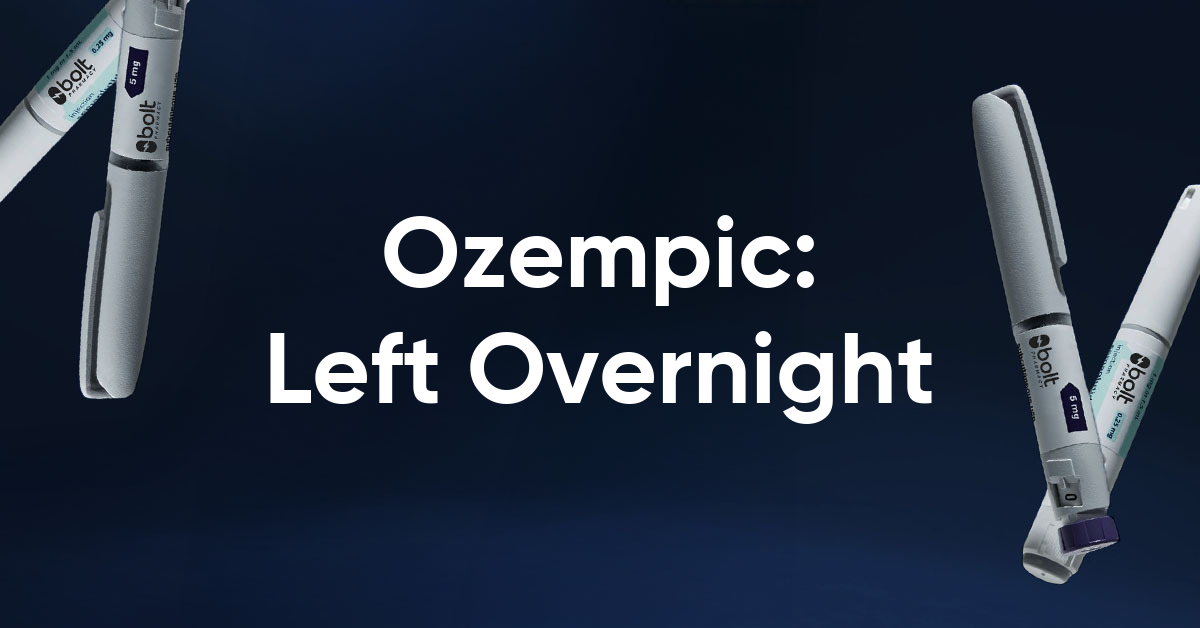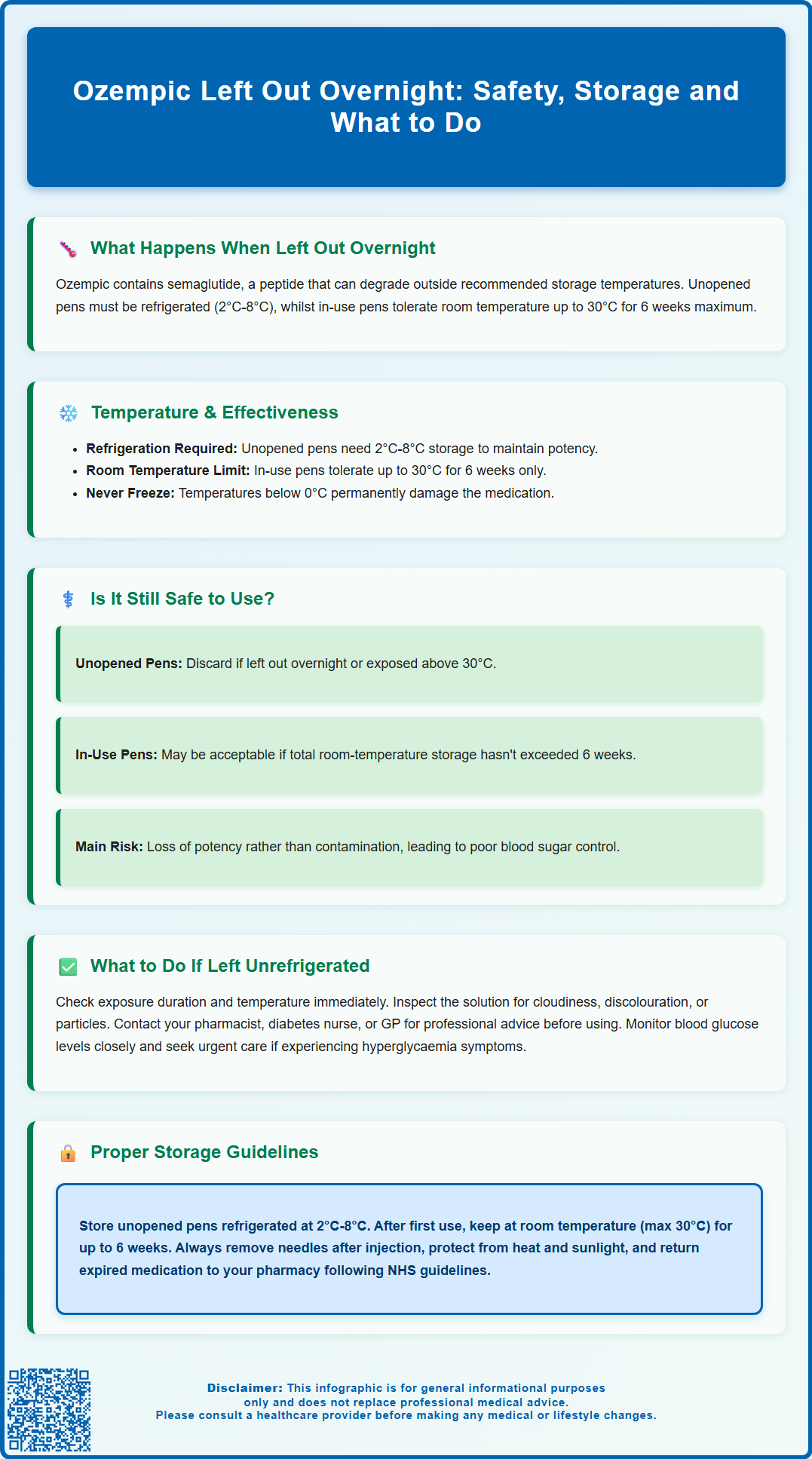Mounjaro®
Dual-agonist support that helps curb appetite, hunger, and cravings to drive substantial, sustained weight loss.
- ~22.5% average body weight loss
- Significant weight reduction
- Improves blood sugar levels
- Clinically proven weight loss

Ozempic (semaglutide), a GLP-1 receptor agonist for type 2 diabetes, requires careful storage to maintain effectiveness. Accidentally leaving Ozempic out overnight raises important questions about medication safety and potency. Understanding proper storage conditions—refrigeration for unopened pens and room temperature limits for in-use pens—is essential for optimal diabetes management. This guide explains what happens when Ozempic is left unrefrigerated, how temperature affects its stability, and the steps you should take to ensure safe, effective treatment in line with UK guidance from the MHRA and NHS.
Summary: If Ozempic is left out overnight, its safety depends on temperature, duration, and whether the pen was opened; unopened pens left at room temperature should be assessed by a healthcare professional before use.
Ozempic (semaglutide) is a glucagon-like peptide-1 (GLP-1) receptor agonist used primarily for managing type 2 diabetes mellitus in the UK. Like many biological medicines, Ozempic requires specific storage conditions to maintain its stability and therapeutic effectiveness. When an unopened Ozempic pen is accidentally left out of the refrigerator overnight, the immediate concern centres on whether the medication has been exposed to temperatures outside its recommended storage range.
The active ingredient, semaglutide, is a peptide-based molecule that can degrade when exposed to temperatures outside the recommended range. An overnight exposure—typically 8 to 12 hours—at normal household temperatures (usually between 15°C and 25°C) raises questions about potency and stability. The manufacturer's guidance distinguishes between unopened pens, which should remain refrigerated between 2°C and 8°C, and in-use pens, which may be kept at room temperature (not exceeding 30°C) for up to 6 weeks.
If your unopened Ozempic pen has been left out overnight, the official guidance from the manufacturer (Novo Nordisk) and the Medicines and Healthcare products Regulatory Agency (MHRA) recommends adhering to the licensed storage conditions. Storage outside these conditions means the product is technically outside its approved specifications. It is essential to assess the specific circumstances before deciding whether to use or discard the pen, and consulting your pharmacist, GP or diabetes specialist nurse is strongly advised to ensure patient safety and optimal glycaemic control.

Temperature plays a critical role in preserving the structural integrity of peptide-based medications like Ozempic. Semaglutide is a peptide molecule that relies on precise three-dimensional folding to bind effectively to GLP-1 receptors in the pancreas and other tissues. When exposed to temperatures outside the recommended range, the peptide can undergo changes that may compromise its pharmacological activity.
Refrigeration (2°C to 8°C) is the gold standard for storing unopened Ozempic pens because it helps maintain the medication's potency throughout its shelf life. At these temperatures, the formulation remains stable, and the active ingredient retains its ability to stimulate insulin secretion, suppress glucagon release, and slow gastric emptying—key mechanisms that help regulate blood glucose levels.
Room temperature storage (up to 30°C) is permissible for in-use pens for a maximum of 6 weeks, as specified in the Summary of Product Characteristics (SmPC) approved by the Medicines and Healthcare products Regulatory Agency (MHRA). During this period, the medication remains therapeutically effective, provided it is not exposed to excessive heat or direct sunlight. However, once a pen has been in use or stored at room temperature for 6 weeks, it must be discarded, even if doses remain.
Exposure to temperatures above 30°C is not recommended according to the SmPC. The manufacturer advises against storing Ozempic above this temperature threshold. Additionally, freezing (below 0°C) is equally damaging to the medication. If Ozempic has been frozen, it must not be used, even if it subsequently thaws. Understanding these temperature thresholds is essential for maintaining medication effectiveness and ensuring safe diabetes management.
Determining whether Ozempic remains safe and effective after being left out overnight requires careful consideration of several factors, including the duration of exposure, ambient temperature, and whether the pen was previously opened. Safety in this context refers both to the medication's integrity and to its continued ability to deliver the intended therapeutic effect.
From a microbiological safety perspective, Ozempic pens contain preservatives and are designed as sterile, single-patient-use devices. A single overnight exposure at room temperature is unlikely to result in bacterial contamination, provided the pen cap remained in place and the needle was not attached. However, the primary concern is loss of potency rather than contamination. Using a compromised pen may result in suboptimal glycaemic control, which carries its own clinical risks.
If an unopened pen was left out overnight, the official guidance from the MHRA and the European Medicines Agency (EMA) recommends adhering to licensed storage conditions. Any deviation technically renders the product outside its approved specifications. If the room temperature exceeded 30°C, or if the pen was frozen, the pen should be discarded.
For in-use pens that have already been stored at room temperature as per guidance, an additional overnight exposure is less concerning, provided the cumulative room-temperature storage does not exceed 6 weeks. Patients should keep a record of when the pen was first used to track this timeframe accurately. When in doubt, do not use the medication—contact your GP, diabetes nurse, or pharmacist for advice, and request a replacement prescription if necessary. Never take risks with diabetes medications, as inconsistent dosing can lead to hyperglycaemia or, in some cases, serious complications such as Hyperosmolar Hyperglycaemic State (HHS). If you experience symptoms of very high blood glucose, including extreme thirst, frequent urination, confusion, or drowsiness, seek urgent medical advice.
If you discover that your Ozempic pen has been left out of the fridge, taking prompt and appropriate action is essential to ensure your safety and maintain effective diabetes management. Follow these steps:
1. Assess the situation immediately
Note how long the pen was left out and the approximate room temperature during that period.
Check whether the pen was unopened (never used) or already in use.
Inspect the pen for any visible changes, such as discolouration, cloudiness, or particulate matter in the solution. Ozempic should be clear and colourless; any change in appearance indicates the medication should not be used.
2. Consult the product information
Refer to the patient information leaflet supplied with your Ozempic pen, which outlines storage requirements. The manufacturer (Novo Nordisk) specifies that unopened pens must be refrigerated, while in-use pens may be kept at room temperature (not exceeding 30°C) for up to 6 weeks.
3. Contact a healthcare professional
If you are uncertain whether the pen is still safe to use, contact your community pharmacist, diabetes specialist nurse, or GP practice for guidance. Pharmacists can advise on medication stability and may be able to liaise with your prescriber about a replacement prescription if needed. Do not rely solely on online forums or anecdotal advice, as individual circumstances vary.
4. Do not use the pen if:
It was exposed to temperatures above 30°C
It has been frozen
The solution appears cloudy, discoloured, or contains particles
You are unsure of the duration or temperature of exposure
5. Arrange a replacement
If the pen must be discarded, contact your GP or diabetes clinic to request a new prescription. Explain the circumstances to ensure continuity of care and avoid gaps in treatment, which could compromise your blood glucose control.
6. Monitor for warning signs
If you miss doses or use potentially compromised medication, monitor your blood glucose levels carefully. Seek urgent medical advice if you experience very high readings, excessive thirst, frequent urination, dehydration, vomiting, abdominal pain, drowsiness, confusion, or rapid breathing, which could indicate serious hyperglycaemia or HHS requiring immediate attention.
Adhering to proper storage guidelines is essential for maintaining the safety, efficacy, and longevity of your Ozempic medication. The following recommendations align with MHRA-approved product information and best practices for handling biological medicines in the UK.
Before first use (unopened pens):
Store Ozempic pens in a refrigerator at 2°C to 8°C.
Keep the pen in its original carton to protect it from light.
Do not store the pen in the freezer or freezer compartment. If Ozempic has been frozen, it must be discarded, even after thawing.
Avoid placing the pen near the back of the refrigerator, where temperatures may drop below 2°C.
Check the expiry date printed on the pen and carton; do not use Ozempic beyond this date.
After first use (in-use pens):
Once you have used your Ozempic pen for the first time, it may be stored either in the refrigerator (2°C to 8°C) or at room temperature not exceeding 30°C for up to 6 weeks.
Keep the pen cap on when not in use to protect the medication from light.
Remove the needle after each injection and dispose of it safely in a sharps container. Never store the pen with a needle attached, as this can lead to contamination, air bubbles, or leakage.
Write the date of first use on the pen label to track the 6-week room-temperature storage period.
General storage tips:
Avoid direct sunlight and heat sources such as radiators, windowsills, or car glove compartments, where temperatures can exceed safe limits.
When travelling, use an insulated medication travel case with a cool pack (not frozen) to maintain appropriate temperatures, especially during warm weather.
If you are flying, keep Ozempic in your hand luggage, as hold luggage can be exposed to freezing temperatures at altitude.
Store the pen out of reach of children and pets.
Disposal:
Discard used or expired Ozempic pens according to local NHS guidelines. Unused medication (without needles) can be returned to your community pharmacy for safe disposal. For needles and used pens, use a prescribed sharps bin and follow your local council or NHS arrangements for sharps collection or return. Never dispose of medications or needles in household waste or down the drain, as this poses environmental and safety risks.
By following these storage guidelines, you can ensure that your Ozempic remains effective throughout its licensed shelf life, supporting optimal diabetes management and reducing the risk of treatment failure due to medication degradation. If you have any questions about storage or handling, your pharmacist or diabetes specialist nurse can provide tailored advice and support.
If an unopened Ozempic pen was left out overnight at normal room temperature, consult your pharmacist or GP before using it, as it is outside approved storage conditions. In-use pens already stored at room temperature may still be safe if the total room-temperature period does not exceed 6 weeks and the temperature stayed below 30°C.
Unopened Ozempic pens must be refrigerated at 2°C to 8°C. Once in use, pens may be stored at room temperature not exceeding 30°C for up to 6 weeks, protected from light and never frozen.
Discard any Ozempic pen that has been frozen or exposed to temperatures above 30°C, as the medication's effectiveness cannot be guaranteed. Contact your GP or diabetes clinic for a replacement prescription to maintain continuous treatment.
The health-related content published on this site is based on credible scientific sources and is periodically reviewed to ensure accuracy and relevance. Although we aim to reflect the most current medical knowledge, the material is meant for general education and awareness only.
The information on this site is not a substitute for professional medical advice. For any health concerns, please speak with a qualified medical professional. By using this information, you acknowledge responsibility for any decisions made and understand we are not liable for any consequences that may result.
Lorem ipsum dolor sit amet, consectetur adipiscing elit, sed do eiusmod tempor incididunt ut labore et dolore magna aliqua. Ut enim ad minim veniam, quis nostrud exercitation ullamco laboris nisi ut aliquip ex ea commodo consequat. Duis aute irure dolor in reprehenderit in voluptate velit esse cillum dolore eu fugiat nulla pariatur.
Block quote
Ordered list
Unordered list
Bold text
Emphasis
Superscript
Subscript